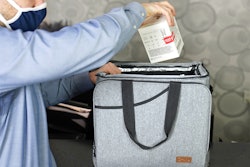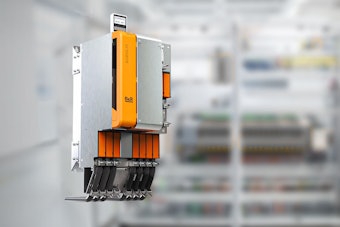 | Read the transcript below: |
Hello, this is Pat Reynolds of Packaging World Magazine, with a look at a few things seen and heard at day two of PACK EXPO Las Vegas.
Highlighted at the C-3825 booth of Domino Printing Sciences, was the new R-Series range of smart vision systems for automatic inspection and validation of product codes, including of course, date codes, batch numbers, bar codes, and 2D printed codes.
The R-Series was developed in consultation with customers following Domino's acquisition of Lake Image Systems. It's not that manufacturers previously had no way of validating codes, but validation technology had to come from a source other than Domino. With the launch of the R-Series, Domino seeks to deliver customer value by reducing complexity and offering a complete end-to-end solution from one single trusted partner. Specifically designed to work with Domino printers and coders, the R-Series eliminates the need for manual code validation and inspection, or the complexity of buying an automated validation system from some other OEM. This significantly reduces the risk of an incorrect code leaving a manufacturing site unnoticed, while allowing for more efficient use and distribution of resources.
R-Series systems have been developed to work alongside Domino printers, integrating seamlessly into existing production lines, without the need for custom brackets or specialist add-ons. R-Series controllers can be run from a single human machine interface and have a standard user interface with Domino look and feel, which is easy to learn and reduces the need for additional training. Unlike other vision systems, the R-Series is specifically designed for coding and marking applications. The systems are optimized for Domino fonts, print characteristics, and inks, and they match the speed of Domino's fastest printers. The R-Series is available as three separate products with custom options available to cater to all requirements and budgets.
Meanwhile, at the Harpak-ULMA booth number 6101 in the South Hall, a key emphasis was on a package format not seen very much in the US but one that is increasingly popular in Europe and that would be a trayless, ground meat, back flushed with a mix of oxygen and carbon dioxide and wrapped on a flow wrapper.
Harpak-ULMA Flow Wrap Product Manager, Hugh Crouch, who also talked about the format at an innovation stage presentation at PACK EXPO, believes this concept has a shot at being adopted in the US because by eliminating the tray, there is not only a cost savings, but also a source reduction advantage.
In addition to removing one whole piece of by going trayless, you also eliminate the trucks and the fuel they would consume when trays need to be delivered. As Crouch put, "Just send a roll of film to the meat packer, and that's it."
The Harpak-ULMA Flow Wrappers recommended for trayless ground meat are either the ULMA FM300 for speeds to 70 packs a minute, or the FM500, for up to 130 packs a minute. The film's being applied very considerably, according to shelf life requirements. Crouch admits that, historically at least, the US consumer has not been all that receptive to ground meat packaging formats, other than the tray plus film overwrap. But considering how vociferous you consumers have become where sustainability is concerned, he thinks it may be time to try this format in the US and in fact, testing is now underway.
Crouch also points out that the shelf life of such packs in the US marketplace, would need to be longer than what is required in Europe, due to the greater distances that fresh ground meat needs to travel on this side of the Atlantic. So, the flexible films and gas mixtures used would likely need some tweaking.
Finally, Aagard, PACK EXPO booth number 5919, there was plenty of talk about, and video footage of, the remarkably flexible 436 case packer, even though the machine itself did not make the trek to Las Vegas. It's what we call an indiscriminate case packer, is how Aagard's Applications Engineering Manager, Jonas Capistrant described it to me. Typically, case packers are designed around the idea of all cases being oriented one way, but this case packer doesn't care, for example, about the orientation of the manufacturer's joint on incoming case blanks. That makes it unique.
Or picture some customers who have cases whose printing is oriented one way and other cases with printing oriented another way. They can't run such cases on one case packer. But with this new machine from Aagard, they can. The 436 case packer handles 30 RSC or HSC cases per minute, features of bulk magazine feed, so that stacks of case blanks can be placed on a floor level roller conveyor that feeds an elevator, taking them to an upper level, where they get picked and sent into the case erecting station. This represents a considerable improvement over the more typical routine of having an operator lift a stack of cases and place them into a magazine feed.
Looking to the future, Capistrant asked, "At what point might we remove the operator who is loading stacks of blanks and insert a robot to load them automatically?" "Additional development now underway," said Capistrant, "Will enable the machine to perform an inspection of each case and validate that the case blank is good so that substandard case blanks can be automatically kicked out. Photo cells and other conventional scanning devices could perhaps be used for this inspection," though Capistrant says, "There have also been discussions with Cognex about deploying some 3D scanners. These would make it possible to not only inspect for proper orientation of the case, but also for defects like torn flaps and so forth."
The 436 also has a unique walkthrough feature that lets an operator, or technician, avoid having to walk all the way around the machine, should an issue on the other side of the machine need to be addressed. There is no need for a walkover, or a safety gate, or a liftable gate, or anything for that matter and you can walk right through while the machine is running.
Other features on the new case packer are diagnostic lighting and automated changeover. With the diagnostic lighting, the operator sees a blue light if the supply of corrugated cases is low. Or if there is a fault, the light turns red. If everything is running smoothly, the light remains white. It saves the operator a lot of time looking at the HMI panel, to understand what needs attention.
As for automated changeover, it's assisted by the more than two dozen Rockwell Servo Motors on the machine. "You push a button at the HMI and the machine changes over to the next recipe," says Capistrant. Case loading funnels get wider or narrower. The compression assembly moves appropriately and so on. Plus, there are adjustable change part, so there are no change parts dedicated to any particular size.
Well, that's all for now, but I will be back tomorrow with a few observations on the closing day of PACK EXPO Las Vegas.
























